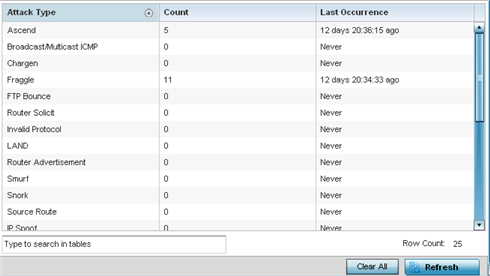Viewing Denial of Service Statistics
A DoS attack (denial-of-service attack), or distributed denial-of-service attack, is an attempt to make a computer resource unavailable to its intended users. Although the means to carry out a DoS attack may vary, it generally consists of a concerted effort to prevent an Internet site or service from functioning efficiently.
One common attack involves saturating the target's (victim's) machine with external communications requests, such that it cannot respond to legitimate traffic, or responds so slowly as to be rendered effectively unavailable. DoS attacks are implemented by either forcing the targeted computer(s) to reset, or consuming its resources so that it can no longer provide its intended service.
The Denial of Service screen displays attack type, number of occurrences, and time of last occurrence.
To view the denial of service statistics:
- Select the Statistics menu from the Web UI.
- Expand the System node from the navigation pane (on the left-hand side of the screen). The System node expands to display the RF Domains created within the managed network.
- Expand the RF Domain node.
- Select a Wireless Controller.
- Expand the Firewall menu from the left-hand side of the UI.
- Select Denial of Service.The screen displays in the right-hand pane.
 This screen displays the following:
This screen displays the following:Attack Type Displays the DoS attack type. Controllers and service platforms support enabling or disabling 24 different DoS attack filters.
Count Displays the number of times each DoS attack was observed by the controller or service platform‘s firewall.
Last Occurrence Displays when the DoS attack was last observed by the controller or service platform‘s firewall.
- Select Clear All to revert the statistics counters to zero and begin a new data collection.
- Select the Refresh button to update the screen's statistics counters to their latest values.

